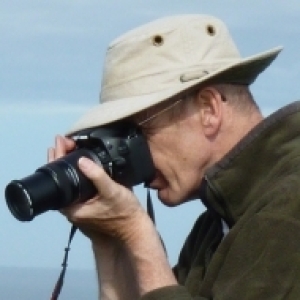Small Canada Goose - Branta hutchinsii
35,000 Barnacle Geese - now that's an impressive sight. A Canada Goose, not quite so impressive. Searching for a Canada Goose among 35,000 Barnacle Geese - mad really.
As justification for the madness:
At least five forms of Canada Geese have appeared in Britain and Ireland as vagrants from North America and Arctic Greenland - the nominate canadensis (Atlantic Canada Goose), interior (Todd's Canada Goose), parvipes (Lesser Canada Goose), taverneri (Taverner's Canada Goose) and hutchinsii (Richardson's Canada Goose). A further form - minima (Cackling Canada Goose) - has also occurred, but these are generally considered to be escapes from captivity.
Richardson's Canada Goose is by far the most frequent form recorded and this, being one of the four smaller forms, is conveniently (but not necessarily correctly) lumped together and considered a separate species - the Small Canada Goose Branta hutchinsii. Separation of these five forms is problematic and far from an exact science considering the intergradation that takes place across northern North America during the breeding season.
Islay is an excellent place to find vagrant Canada Geese, with as many as 7 individuals regularly wintering there, either with Barnacle Geese or Greenland White-fronted Geese. The favoured haunt is the fields and mudflats surrounding Loch Gruinart RSPB.
RCB has a closer view of the Small Canada Goose too, although with his cropping it could be any old Canada Goose unless you're up with the taxonomic differences:
Richardson's (or Baffin Island) Canada Goose (B. c. hutchinsii). Small and dumpy with a square-looking head and short bill. Often short-legged. Can appear silvery at distance. This is the smallest and the palest of the pale forms, especially on the breast. Rarely a pale collar may be present, however, often the lower border of the dark neck may simply appear diffuse as paler feathers are admixed with the dark. Hutchinsii have a shorter and deeper bill (appears stubby) than parvipes. Hutchinsii is known to intergrade with parvipes in an overlap zone around Hudson Bay. The average hutchinsii is larger than the largest minima, but that there is overlap. Breeding in the arctic, Common migrant to central and eastern Texas wintering on the coastal plain, Panhandle and South Plains. Also in northern Mexico.
Oh and now just to add to the confusion a Guardian Science Blogpost:
This is an adult cackling goose, Branta hutchinsii (formerly; Branta canadensis hutchinsii), also known (incorrectly) as the Lesser, Small or Cackling Canada goose.
This "miniature" goose was recently separated from its much larger close relative, the Canada goose, B. canadensis. Cackling geese have a distinctly different voice and facial structure than Canada geese, they nest further north than their larger cousins, and rarely (if ever) interbreed with them. The cackling goose pop up in western Europe from time to time and occasionally reach the Kamchatka Peninsula in eastern Siberia, also eastern China and Japan.
The AOU (American Ornithologists' Union) assigned the many associated subspecies as follows:
Richardson's cackling goose, Branta hutchinsii hutchinsii
Aleutian cackling goose, Branta hutchinsii leucopareia
small cackling goose, Branta hutchinsii minima
the "lesser complex", Branta hutchinsii taverneri
Bering cackling goose, Branta hutchinsii asiatica
- 0
- 0
- Panasonic DMC-TZ8
- 1/100
- f/4.0
- 5mm
- 80

Comments
Sign in or get an account to comment.


